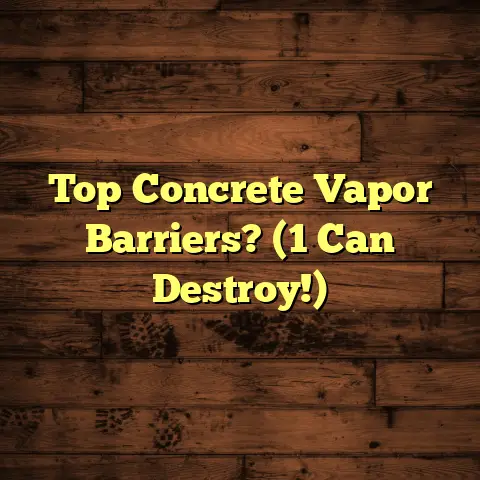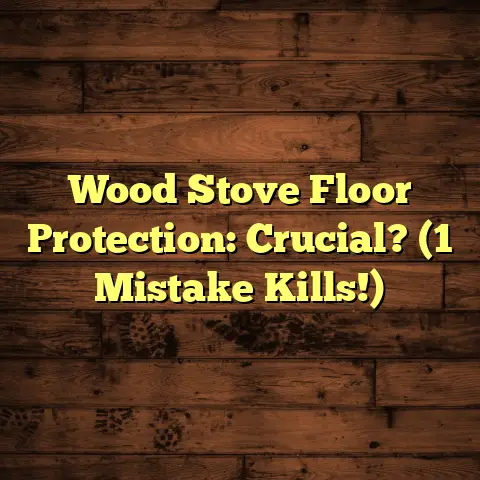Paint Concrete Like Slate (4 Pro Texture Steps!)
I’ve noticed a surge in homeowners ditching expensive materials like natural slate for a surprisingly affordable alternative: painted concrete.
Think about it: you can achieve that high-end,
sophisticated slate look without breaking the bank.
Plus, concrete is incredibly durable and versatile,
making it perfect for both indoor and outdoor spaces.
In this article, I’m going to walk you through
my proven, four-step process for painting concrete
to look like slate.
Get ready to transform your
space with this budget-friendly and stylish solution!
Section 1: Understanding the Slate Look
What Makes Slate Attractive
Let’s be honest, slate is gorgeous.
It’s got this
natural, earthy vibe that’s hard to resist.
What I love most about slate is its unique texture.
Each piece is different, with subtle variations
in color and pattern.
It adds depth and character
to any room or outdoor area.
Slate’s also known for its sophisticated, timeless
appeal.
It’s a material that elevates a space,
making it feel more luxurious and inviting.
Benefits of Concrete
Now, let’s talk about concrete.
I know, I know,
it might not sound as glamorous as slate, but hear
me out.
Concrete is a workhorse!
It’s incredibly strong and durable, which means
it can withstand heavy foot traffic and harsh weather
conditions.
I’ve seen concrete floors last for decades
with minimal maintenance.
Concrete’s also super versatile.
You can stamp it,
stain it, polish it, and, of course, paint it!
It’s a blank canvas just waiting for your creative
touch.
Overview of Painting Concrete
So, how do we bridge the gap between humble concrete
and elegant slate?
That’s where the magic of paint
comes in.
By using specific painting techniques and color combinations, we can mimic the look of natural slate on a concrete surface.
Trust me, I’ve done this countless times, and the
results are always stunning.
You get the look of
slate without the hefty price tag or complicated
installation process.
Section 2: Preparing Your Concrete Surface
Okay, before we even think about paint, we need to
prep our concrete surface.
This is the most crucial
step!
A poorly prepared surface will lead to peeling,
chipping, and an overall disappointing result.
Take
your time and do it right.
Cleaning the Surface
First things first, we need to get rid of any dirt,
grease, or old paint.
I usually start by sweeping
the surface thoroughly.
Then, I scrub it with a mixture of warm water and
a degreasing cleaner.
For stubborn stains, I use
a pressure washer.
Just be careful not to damage
the concrete!
If there’s old paint, I recommend using a paint
scraper or a chemical stripper to remove it.
Make
sure to follow the manufacturer’s instructions
carefully.
Repairing Imperfections
Now, let’s address any cracks or pits in the concrete.
These imperfections will show through the paint,
so it’s important to fix them.
For small cracks, I use a concrete crack filler.
For larger holes, I use a concrete patching compound.
I apply the filler or compound according to the manufacturer’s instructions, making sure to smooth it out and let it dry completely.
Etching the Concrete
Etching the concrete is essential for proper paint
adhesion.
Concrete is naturally smooth, which means
paint doesn’t stick to it very well.
Etching creates a slightly rough surface, giving
the paint something to grip onto.
I use a concrete
etching solution, which you can find at most hardware
stores.
Here’s how I do it:
- Protect yourself: Wear gloves, eye protection,
and a respirator. This stuff is strong! - Mix the solution: Follow the manufacturer’s
instructions for diluting the etching solution
with water. - Apply the solution: Pour the solution onto
the concrete surface and scrub it with a stiff
brush. - Rinse thoroughly: Rinse the surface with
plenty of clean water until all traces of the
etching solution are gone. - Let it dry: Allow the concrete to dry completely
before moving on to the next step.
Priming the Surface
Priming is another crucial step for ensuring proper
paint adhesion.
A good concrete primer will create
a uniform surface and help the paint bond to the
concrete.
I always use a primer specifically designed for
concrete.
These primers are formulated to penetrate
the concrete and create a strong bond.
I apply the primer with a roller, making sure to
cover the entire surface evenly.
I let it dry completely
before moving on to the next step.
Section 3: Choosing Your Paint and Tools
Alright, now for the fun part: choosing your paint
and tools!
This is where you can really get creative
and customize the look of your slate.
Selecting the Right Paint
When it comes to painting concrete to look like slate, you have a few options:
- Acrylic paint: This is a popular choice
because it’s durable, water-resistant, and easy
to apply. - Epoxy paint: Epoxy paint is even more durable
than acrylic, making it a good choice for high-traffic
areas. - Concrete stain: Concrete stain penetrates the
concrete, creating a natural-looking color that
won’t peel or chip.
I personally prefer acrylic paint for this project because it’s easy to work with and provides a great slate-like finish.
Color and Texture Options
Now, let’s talk about color.
Slate comes in a variety
of colors, from dark grays and blacks to lighter
blues and greens.
I recommend choosing a color palette that mimics
the natural colors of slate.
You can also mix and
match colors to create a more unique look.
Here are a few popular color combinations I’ve used:
- Dark gray base with lighter gray and black
accents - Blue-gray base with green and brown accents
- Charcoal gray base with white and silver accents
As for texture, we’ll be creating that in the next section!
Essential Tools
Here’s a list of the tools you’ll need for this project:
- Paintbrushes: For applying the base coat and
adding details. - Rollers: For applying the base coat to large
areas. - Spray gun (optional): For applying the base
coat and sealer. - Sponges: For creating texture.
- Stippling brush: For creating texture.
- Texture rollers: For creating texture.
- Stencils (optional): For adding patterns and
designs. - Paint trays: For holding paint.
- Painter’s tape: For masking off areas.
- Drop cloths: For protecting your work area.
Section 4: The Four Pro Texture Steps to Paint Concrete Like Slate
Okay, here’s where the magic happens!
We’re going
to transform our primed concrete surface into a
stunning slate look-alike.
Step 1: Base Coat Application
First, we need to apply the base coat.
This is the
foundation for our slate look, so it’s important
to get it right.
I use a roller to apply the base coat, making sure
to cover the entire surface evenly.
I usually apply
two coats, allowing each coat to dry completely
before applying the next.
The base coat color should be the dominant color
of your desired slate look.
For example, if you’re
going for a dark gray slate, your base coat should
be a dark gray.
Step 2: Creating Texture
Now for the fun part: adding texture!
This is what
will really make your concrete look like slate.
There are several techniques you can use to create texture:
- Sponge painting: Dab a damp sponge into paint
and then dab it onto the concrete surface.
This
creates a mottled, uneven texture. - Stippling: Use a stippling brush to dab paint
onto the concrete surface.
This creates a more
pronounced, textured effect. - Texture rollers: These rollers have a textured
surface that transfers to the concrete as you roll
them.
I personally like to use a combination of sponge painting and stippling to create a realistic slate texture.
Step 3: Adding Veining and Depth
Slate has natural veining and variations in color
that add depth and character.
We can mimic this by
adding contrasting colors to our textured surface.
I use a small brush to apply thin lines of contrasting
color to the surface, following the natural contours
of the texture.
I then use a damp sponge to blend
the colors together, creating a subtle, natural-looking
effect.
Step 4: Sealing the Surface
Finally, we need to seal the painted concrete to
protect it from wear and tear.
A good sealer will
also enhance the finish and make it easier to clean.
I recommend using a concrete sealer specifically
designed for painted surfaces.
These sealers are
formulated to protect the paint and prevent it from
peeling or chipping.
I apply the sealer with a roller or spray gun, making
sure to cover the entire surface evenly.
I usually
apply two coats, allowing each coat to dry completely
before applying the next.
Conclusion
And there you have it!
You’ve successfully transformed
your concrete surface into a stunning slate look-alike.
With the right preparation, materials, and techniques, anyone can achieve this budget-friendly and stylish look.
I encourage you to take the plunge and try this project
yourself.
I’m confident that you’ll be amazed by
the results.
I’d love to hear about your experiences and see
your finished projects.
Feel free to share your
results or ask any questions in the comments below.
Happy painting!





